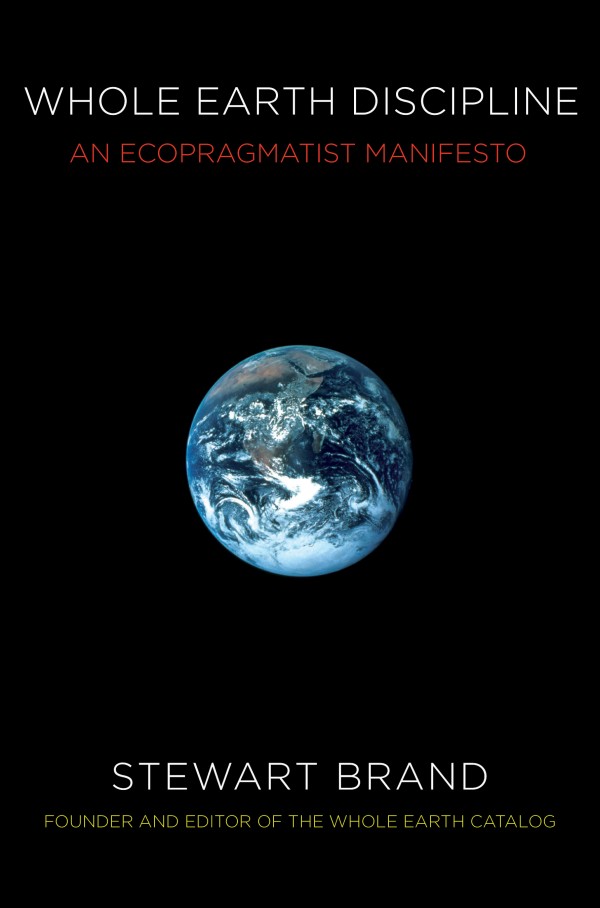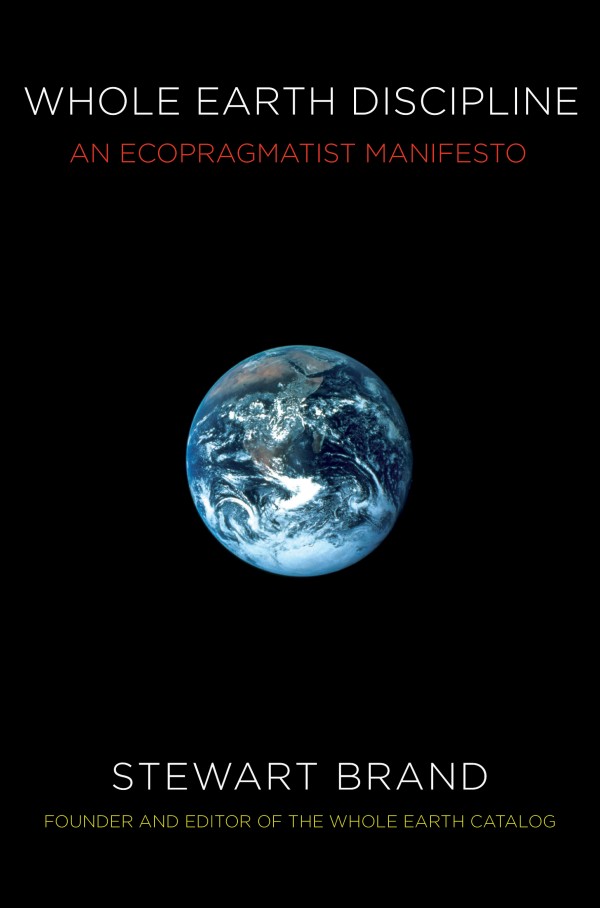Supporting technical details and citations for this post can be found here: “Four Nuclear Myths” (PDF).
 Whole Earth Discipline, by Stewart Brand (Viking, 2009)I have known Stewart Brand as a friend for many years. I have admired his original and iconoclastic work, which has had significant impact. In his new book, Whole Earth Discipline: an Ecopragmatist Manifesto (Viking), he argues that environmentalists should change their thinking about four issues: population, nuclear power, genetically modified organisms (GMOs), and urbanization. Many people have asked me to assess his 41-page chapter on nuclear power, so I’ll do that here, because I believe its conclusions are greatly mistaken.
Whole Earth Discipline, by Stewart Brand (Viking, 2009)I have known Stewart Brand as a friend for many years. I have admired his original and iconoclastic work, which has had significant impact. In his new book, Whole Earth Discipline: an Ecopragmatist Manifesto (Viking), he argues that environmentalists should change their thinking about four issues: population, nuclear power, genetically modified organisms (GMOs), and urbanization. Many people have asked me to assess his 41-page chapter on nuclear power, so I’ll do that here, because I believe its conclusions are greatly mistaken.
Stewart recently predicted that I wouldn’t accept his nuclear reassessment. He is quite right. His nuclear chapter’s facts and logic do not hold up to scrutiny. Over the past few years, I’ve sent him five technical papers focused mainly on nuclear power’s comparative economics and performance. He says he’s read them, and on p. 98 he even summarizes part of their economic thesis. Yet on p. 104 he says, “We Greens are not economists” and disclaims knowledge of economics, saying environmentalists use it only as a weapon to stop projects. Today, most dispassionate analysts think new nuclear power plants’ deepest flaw is their economics. They cost too much to build and incur too much financial risk. My writings show why nuclear expansion therefore can’t deliver on its claims: it would reduce and retard climate protection, because it saves between two and 20 times less carbon per dollar, 20 to 40 times slower, than investing in efficiency and micropower.
That conclusion rests on empirical data about how much new nuclear electricity actually costs relative to decentralized and efficiency competitors, how these alternatives compare in capacity and output added per year, and which can most effectively save carbon. Stewart’s chapter says nothing about any of these questions, but I believe they’re at the heart of the matter. If nuclear power is unneeded, uncompetitive, or ineffective in climate protection, let alone all three, then we need hardly debate whether its safety and waste issues are resolved, as he claims.
In its first half-century, nuclear power fell short of its forecast capacity by about 12-fold in the U.S. and 30-fold worldwide, mainly because building it cost several-fold more than expected, straining or bankrupting its owners. The many causes weren’t dominated by U.S. citizen interventions and lawsuits, since nuclear expectations collapsed similarly in countries without such events; even France suffered a 3.5-fold rise in real capital costs during 1970-2000. Nor did the Three Mile Island accident halt U.S. orders: they’d stopped the previous year. Rather, nuclear’s key challenge was soaring capital cost, and for some units, poor performance. Operational improvements in the ’90s made the better old reactors relatively cheap to run, but Stewart’s case is for building new ones. Have their economics improved enough to prevent a rerun?
On the contrary, a 2003 MIT study found new U.S. nuclear plants couldn’t compete with new coal- or gas-fired plants. Over the next five years, nuclear construction costs about tripled. Was this due to pricey commodities like steel and concrete? No; those totaled less than one percent of total capital cost. Were citizen activists again to blame? No; they’d been neutralized by streamlined licensing, adverse courts, and Federal “delay insurance.” The key causes seem to be bottlenecked supply chains, atrophied skills, and a weak U.S. dollar — all widening the cost gap between new nuclear power and its potent new competitors.
Today’s main alternatives aren’t limited to giant power plants burning coal or natural gas. Decentralized sources provide from one-sixth to more than half of all electricity in a dozen industrial countries and, together with more efficient use, deliver the majority of the world’s new electrical services. Booming orders did lately raise wind-turbine and photovoltaic prices too, but they’re headed back down as capacity catches up; PVs got one-fourth cheaper just in the past year, and reactor-scale PV farms compete successfully in California power auctions. New U.S. wind farms — “firmed” to provide reliable power even if becalmed — sell electricity at less than typical wholesale prices, or at a third to a half the cost utilities project for new nuclear plants.
Rather than viewing nuclear power within this real-world competitive landscape, Stewart simply waves away its competitors. He praises efficient use of electricity, but rejects it because he says it can’t by itself replace all coal and power all global development. He also dismisses wind and solar power, and omits small hydro, geothermal, waste/biomass combustion, all other renewables, and cogeneration. Yet worldwide these sources make more electricity than nuclear power does, and for the past three years, have won about 10-25 times its market share and added about 20-40 times more capacity each year.
The world in 2008 invested more in renewable power than in fossil-fueled power. Why? Because renewables are cheaper, faster, vaster, equally or more carbon-free, and more attractive to investors. Worldwide, distributed renewables in 2008 added 40 billion watts and got $100 billion of private investment; nuclear added and got zero, despite its far larger subsidies and generally stronger government support. From August 2005 to August 2008, with new subsidies equivalent to 100+% of construction cost and with the most robust nuclear politics and capital markets in history, the 33 proposed U.S. nuclear projects got not a cent of private equity investment.
Nonetheless, Stewart rejects all non-nuclear options, for four fallacious reasons:
- Baseload: Wind and photovoltaics can’t keep the lights on because they can’t run 24/7.
- Footprint: Photovoltaics need about 150-175 times, and wind farms from 600+ to nearly 900 times, more land than nuclear power to produce the same electricity.
- Portfolio: We need every tool for combating climate change, including nuclear power.
- Government role: The climate imperative trumps economics, so governments everywhere must and will do what France did — ensure that nuclear power gets built, regardless of economics or dissent.
I believe each claim is unsupportable:
Baseload: The electricity system doesn’t rely on any plant’s ability to run continuously; rather, all plants together supply the grid, and the grid serves all loads. That’s necessary because no kind of power plant can run all the time, as Stewart says they must do to meet steady loads. I repeat: there is not and has never been a need for any particular plant or kind of plant to run all the time, and none can. All power plants fail, varying only in their failures’ size, duration, frequency, predictability, and cause. Solar cells’ and windpower’s variation with night and weather is no different from the intermittence of coal and nuclear plants, except that it affects less capacity at once, more briefly, far more predictably, and is no harder and probably easier and cheaper to manage. In short, the ability to serve steady loads is a statistical attribute of all plants on the grid, not an operational requirement for one plant. Variability (predictable failure) and intermittence (unpredictable failure) must be managed by diversifying type and location, forecasting, and integrating with other resources. Utilities do this every day, balancing diverse resources to meet fluctuating demand and offset outages. Even with a largely (or probably a wholly) renewable grid, this is not a significant problem or cost, either in theory or in practice — as illustrated by areas that are already 30-40% wind-powered.
Footprint: Stewart understates nuclear power’s land-use by about 43-fold by omitting all land used by exclusion zones and the nuclear fuel chain. Conversely, he includes the space between wind or solar equipment — unused land commonly used for farming, grazing, wildlife, and recreation. That’s like claiming that two lampposts require a parking lot’s worth of space, even though 99% of the lot is used for parking, driving, and walking. Properly measured, per kilowatt-hour produced, the land made unavailable for other uses is about the same for ground-mounted photovoltaics as for nuclear power, sometimes less — or zero, for building-mounted PVs sufficient to power the world many times over. Land actually used per kWh is up to thousands of times smaller for windpower than for nuclear power. If land-use were an important criterion for picking energy systems, which it’s generally not, it would thus reverse Stewart’s footprint conclusion.
Portfolio: The one paper he cites as proof that we need all energy options (Pacala & Socolow’s “Stabilization Wedges“) actually says the opposite. There is no analytic basis for his conclusion, and there’s strong science to the contrary. We can’t afford to stuff our energy portfolio indiscriminately with some of everything, and we shouldn’t: some options are less worthy and effective than others. The more you fear climate change, the more judiciously you should invest to get the most solution per dollar and per year. Nuclear flunks both these tests.
Government: If nuclear power isn’t needed, worsens climate change (vs. more effective solutions) and energy security, and can’t compete in the marketplace despite uniquely big subsidies — all evidence-based findings unexamined in Stewart’s chapter — then his nuclear imperative evaporates. Of course, a few countries with centrally planned energy systems, mostly with socialized costs, are building reactors: over two-thirds of all nuclear plants under construction are in China, Russia, India, or South Korea. But that’s more because their nuclear bureaucracies dominate national energy policy and face little or no competition in technologies, business models, and ideas. Nuclear power requires such a system. The competitors beating nuclear power thrive in democracies and free markets.
—
Stewart’s reputation and his valuable prior contributions to clear thinking for a better world may win his nuclear views some attention. Yet judged on its merits, not his history, this nuclear chapter’s assertions can only worsen climate and security risks.



